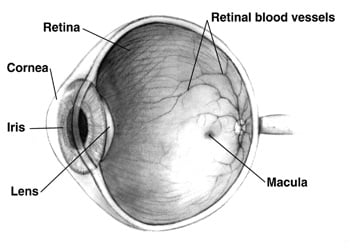University of Queensland (UQ) scientists have made a fundamental breakthrough into how the brain decodes the visual world.
Using advanced electrical recording techniques, researchers at UQ’s Queensland Brain Institute (QBI) have discovered how output cells of the eye’ balls retina compute the direction of a moving object.
QBI’s Dr Ben Sivyer and Associate Professor Stephen Williams have found that dendrites – the branching process of a neuron that conducts impulses toward the cell – play a critical role in decoding images.
“In the past decade our research shows that dendrites provide neurons with powerful processing capabilities,” Associate Professor Williams said.

“However the function of dendritic processing in the real-time operation of neuronal networks has remained elusive.”
To gain further insight, the group measured electrical activity from multiple sites in retinal ganglion cells when visual stimuli moved through space.
“The retina, a thin neuronal network at the posterior part of the eyeball, is ideal for investigating the role of active dendritic integration in neuronal circuit function,” he said.
“This is because this network can be maintained intact in a dish and retains its responsiveness to natural stimuli.”
He said while it had long been known that the retinal network extracted and signalled specific aspects of visual stimuli, the new work has discovered how such responses are computed.
“We found that retinal ganglion cells compute the direction of light stimuli through exquisitely controlled local integration compartments in the dendritic tree, a finding which highlights the key function that dendrites play in brain computations,” said Associate Professor Williams.
QBI Director Professor Perry Bartlett said this new insight was vital to brain research.
“Discovering how nerve cells process information is fundamental to understanding how we learn, and to developing new strategies to enhance learning in education and in disease processes in the brain,” he said.
Queensland Minister for Science and Innovation Ian Walker congratulated Dr Sivyer and Associate Professor Williams on their internationally significant findings.
“This is another example of Queensland leading the world in health and medical research,” he said.
“Dendrite research also has flow-on implications for brain-function studies in a range of areas.
“While all of these areas are important, I will be particularly interested to see its application to dementia research, which has been a major focus for recent Queensland Government support.”
Notes about this neuroscience research
The paper, Direction selectivity is computed by active dendritic integration in retinal ganglion cells, is published in the prestigious journal Nature Neuroscience.
Contact: Mikaeli Costello – University of Queensland
Source: University of Queensland press release
Image Source: The image is credited to NIH/National Eye Institute and is in the public domain.
Original Research: Abstract for “Direction selectivity is computed by active dendritic integration in retinal ganglion cells” by Benjamin Sivyer and Stephen R Williams in Nature Neuroscience. Published online October 27 2013 doi:10.1038/nn.3565






